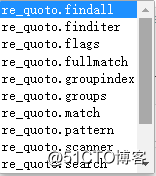import re
import sys
sys.argv?# 函数
# re.compile(pattern, flags=0) --regex 返回的对象是regex
# re.search(pattern, flags=0) --match 返回的对象是match
# re.match(pattern,string, flags=0) --match
# re.fulimatch(match, string, flags=0) --match
# re.findall(pattern, string flags=0) --list
# re.finditer(pattern, string, flags=0) --iterator
# re.sub(pattern, repl, string, count=0, flags=0) --str
# re.subn(pattern, reple, string, count=0, flags=0) --tuple
# re.escape(pattern) --characters
# repurge()# 常量
# re.A/re.ASCII让\w,\W,\b,\B,\d,\D,\s和\S禁止性ASCII-匹配
# re.DEGUG 暂时debug信息
# re.I ignore忽略大小写
# re.L locale 表示特殊字符集 \w\W \b,\B,\s,\S依赖于当前环境
# re.M multiline 多行模式
# re.S dotall 即为
# re.X verbose 为了增加可读性,忽略恐吓和‘#’后面的注释# import re
# re.compile() 创建一个正则对象regex,一个变量对此使用
# regex = re.compile(pattern) # 使用regex对象,推荐,应用更灵活
# result = regex.match(string)
# ==
# match = re.match(pattern, string)
# 3, 使用regex查找一个字符串,返回被匹配的对象
# 4, 调用陪陪对象的group方法,返回实际匹配的文本import re # 使用match对象
re.search(‘coop‘,‘coop is a hero‘)<_sre.SRE_Match object; span=(0, 4), match=‘coop‘>match = re.search(‘coop‘,‘who is coop?‘)print(match.group())coopmatch<_sre.SRE_Match object; span=(7, 11), match=‘coop‘>match = re.search(‘coop‘,‘how are you‘)print(match.group())---------------------------------------------------------------------------
AttributeError Traceback (most recent call last)
<ipython-input-26-75394e24da25> in <module>()
----> 1 print(match.group())
AttributeError: ‘NoneType‘ object has no attribute ‘group‘import re
s = """
1234-1243-443
110-1231-1234
coop@126.com
110@qq.com
coop@qq.com
html.lee@google.com
http://baidu.com
https://github.com
http://taobao.com
"""
#targ = ‘\d{4}‘
targ = ‘\d{3,4}-\d{4}-\d{3,4}‘ # 如何匹配到前两行号码?
targ = ‘\d+-\d+-\d+‘
match = re.search(targ,s)
if match:
print(‘here:‘,match.group())
else:
print(‘there in no such character‘)here: 1234-1243-443aa = re.match(‘\d{3}‘,‘coop123‘)print(aa)Noneaa = re.match(‘\d{3}‘,‘12coop‘)print(aa)Noneaa = re.match(‘\d{3}‘,‘123456coop‘)print(‘here:‘,aa.group()) # match 只匹配从头开始的字符,如果没有就不匹配here: 123re.match(‘f‘,‘fffffather‘)<_sre.SRE_Match object; span=(0, 1), match=‘f‘>s‘\n1234-1243-443\n110-1231-1234\ncoop@126.com\n110@qq.com\ncoop@qq.com\nhtml.lee@google.com\nhttp://baidu.com\nhttps://github.com\nhttp://taobao.com\n‘# 使用compile生成regex对象
regex = re.compile(‘\n1234‘) # 先生成正则表达式,然后下面直接调用该方法
match = regex.match(s)
print(match)
if match:
print(‘here:‘,match.group(),end=‘‘) # \n1234 \n的作用
else:
print(‘sorry ,there is no such character‘)<_sre.SRE_Match object; span=(0, 5), match=‘\n1234‘>
here:
1234# 使用compile生成regex对象
regex = re.compile(‘1234‘) # 先生成正则表达式,然后下面直接调用该方法
match = regex.match(s)
print(match)
if match:
print(‘here:‘,match.group(),end=‘‘) # \n1234 \n的作用
else:
print(‘sorry ,there is no such character‘)None
sorry ,there is no such characterprint(s)1234-1243-443
110-1231-1234
coop@126.com
110@qq.com
coop@qq.com
html.lee@google.com
http://baidu.com
https://github.com
http://taobao.com# 使用compile生成regex对象
regex = re.compile(‘1234‘) # 先生成正则表达式,然后下面直接调用该方法
match = regex.match(s)
print(match)
if match:
print(‘here:‘,match.group(),end=‘‘) # \n1234 \n的作用
else:
print(‘sorry ,there is no such character‘)None
sorry ,there is no such character # () :括号分组
# | :管道符号匹配多个分组
# ? :选择出现0次或1次
# re.x :换行,注释regex = re.compile(r‘coop‘) # r raw ,原始的regex.findall<function SRE_Pattern.findall(string=None, pos=0, endpos=9223372036854775807, *, source=None)>regex.findall(‘adsfhasdlfcoop124235sdfcoop‘)[‘coop‘, ‘coop‘]##############################regex = re.compile(r‘(coop)‘) # () 分组
regex.findall(‘adsfhasdlfcoop124235sdfcoop‘)[‘coop‘, ‘coop‘]regex.split(‘adsfhasdlfcoop124235sdfcoop‘)[‘adsfhasdlf‘, ‘coop‘, ‘124235sdf‘, ‘coop‘, ‘‘]###########################regex = re.compile(r‘coop‘)
regex.split(‘adsfhasdlfcoop124235sdfcoop‘) #返回的列表,最后又一个空的[‘adsfhasdlf‘, ‘124235sdf‘, ‘‘]regex = re.compile(r‘coop‘)
regex.split(‘adsfhasdlfcoop124235sdfcoop‘,maxsplit=1)[‘adsfhasdlf‘, ‘124235sdfcoop‘]regex = re.compile(r‘coop‘)
regex.split(‘adsfhasdlfcoop124235sdfcoopsdfasd‘) # 更改后,空内容消失[‘adsfhasdlf‘, ‘124235sdf‘, ‘sdfasd‘]############################ 提取IP地址的正则表达式regex = re.compile(r"((2[0-4]\d|25[0-5]|[0-1]?\d\d?)\.){3}(2[0-4]\d|25[0-5]|[0-1]?\d\d?)")
re_ip = regex.match(‘192.168.1.1‘)
re_ip = re_ip.group()
print(re_ip)192.168.1.1##############################regex = re.compile(r"""((2[0-4]\d|25[0-5]|[0-1]?\d\d?)\.) # ip的第一组数字,包含后面的点
{3} # 表示三组数字
(2[0-4]\d|25[0-5]|[0-1]?\d\d?)""" # 最后一组数字
,re.X) # 正则可以换行,可以注释
re_ip = regex.match(‘192.168.1.1‘)
print(re_ip.group())192.168.1.1regex = re.compile(r"""((2[0-4]\d|25[0-5]|[0-1]?\d\d?)\.) # ip的第一组数字,包含后面的点
{3} # 表示三组数字
(2[0-4]\d|25[0-5]|[0-1]?\d\d?)""" # 最后一组数字
,re.X) # 正则可以换行,可以注释
re_ip = regex.match(‘192.168.1.1‘)
print(re_ip)<_sre.SRE_Match object; span=(0, 11), match=‘192.168.1.1‘>import re
regex = re.compile(r"""((2[0-4]\d|25[0-5]|[0-1]?\d?\d?)\.) # ip的第一组数字,包含后面的点
{3} # 表示三组数字
(2[0-4]\d|25[0-5]|[0-1]?\d?\d?)""" # 最后一组数字
,re.X) # 正则可以换行,可以注释
re_ip = regex.match(‘192.168.1.1‘)
print(re_ip)<_sre.SRE_Match object; span=(0, 11), match=‘192.168.1.1‘>import re
regex = re.compile(r"""((2[0-4]\d|25[0-5]|[0-1]?\d?\d)\.) # ip的第一组数字,包含后面的点
{3} # 表示三组数字
(2[0-4]\d|25[0-5]|[0-1]?\d?\d)""" # 最后一组数字
,re.X) # 正则可以换行,可以注释
re_ip = regex.match(‘192.168.1.1‘)
print(re_ip)<_sre.SRE_Match object; span=(0, 11), match=‘192.168.1.1‘>*? 重复任意次,但尽可能少的重复。
+? 重复1次或更多次,但尽可能少的重复。
?? 重复0次或1次,但尽可能少的重复。
{n,}? 重复n次以上,但尽可能少的重复。
# 只匹配双引号中的内容(包含引号)
re_quoto = re.compile(r‘"(.*)"‘)
text1 = ‘Computer says "no."‘
find1 = re_quoto.findall(text1)
print(find1)
text2 = ‘Computer says "no",Phone says "yes." ‘
find2 = re_quoto.findall(text2)
print(find2)[‘no.‘]
[‘no",Phone says "yes.‘]re_quoto = re.compile(r‘"(.*?)"‘)
text1 = ‘Computer says "no."‘
find1 = re_quoto.findall(text1)
print(find1)
text2 = ‘Computer says "no",Phone says "yes,"‘ # 非贪婪匹配,匹配的是"no",和"yes",有双引号
find2 = re_quoto.findall(text2)
print(find2)[‘no.‘]
[‘no‘, ‘yes,‘]re_quoto = re.compile(r‘"(.*?)"‘)
text1 = ‘Computer says "no."‘
find1 = re_quoto.findall(text1)
print(find1)
text2 = ‘Computer says "no,Phone says "yes,"‘ # 非贪婪匹配,匹配的是"no",和"yes",有双引号
find2 = re_quoto.findall(text2)
print(find2)[‘no.‘]
[‘no,Phone says ‘]

原文:http://blog.51cto.com/13118411/2115728